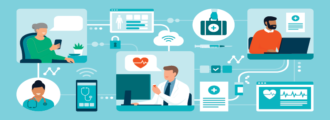The COVID-19 pandemic has exposed a lot of issues in the US healthcare system. The latest findings highlight the struggles hospitals are facing in sharing COVID-19 testing data with government agencies, and the conclusions are surprising.
More than four in 10 U.S. hospitals report that public health agencies are unable to receive electronic data, according to a study published in the Journal of Informatics in Health and Biomedicine. This issue is especially critical these days thanks to its impact on the way COVID-19 cases are reported and treated.
Read on to learn more about how researchers arrived at these numbers, what specific healthcare interoperability issues organizations are facing, and how healthcare orgs can overcome those challenges.
Breaking Down the Data
Researchers from Harvard Business School, University of San Francisco Department of Medicine, and Indiana University’s Richard M. Fairbanks School of Public Health analyzed data from the 2018 American Hospital Association, using that information to identify the most common barriers that hospitals face when reporting patient data.
Next, they compared that data to current COVID-19 projections on total infections, infections requiring hospitalization, infections requiring ICU beds, and projected hospital capacity necessary for COVID-19 patients.
According to their results, 41.2 percent of hospitals said public health agencies were unable to receive data electronically and 31.9 percent of hospitals reported issues with interfaces, such as costs and complexity. Finally, they found other barriers included the inability to extract EHR data, differing data standards, and the inability to send data altogether.
Which brings us to why this report is so shocking. “Despite billions of dollars in federal investment in digitizing the U.S. healthcare system,” researchers wrote, “aggregating information such as test results and potential cases was done in a patchwork way, with data sharing often occurring via fax or phone.”
Two Major Barriers to Exchanging Healthcare Data
This research illustrates the necessity of healthcare interoperability in general, not to mention its importance during a situation like a global pandemic. So why is it so difficult for healthcare systems to get their information to flow more smoothly? Two of the biggest barriers are EHR interface issues and challenges with integration.
EHR Interface Issues—Complexity and Cost
When any two systems are integrated, an interface is created. While these interfaces are critical to the overall success of an EHR system, interface issues can also cause insidious problems because their failures can initially be hidden behind the scenes. Why?
Because most healthcare organizations aren’t using EHRs right out of the box. They often need hundreds (if not thousands) of customizations to make them work for their specific needs, and these customizations, plus their unique interfaces, can cause problems that act like grit in the gears of the virtual machinery. The more complex the system, the larger the disconnect between the manifestation of a problem (a doctor gets an error when trying to send an HL7 message) and what’s actually causing that problem (one part of the system used data standard A while another part uses data standard B).
In addition, implementing and maintaining EHRs can be very costly. You have to factor in the cost of the EHR system, plus routine maintenance, support, and employee training. So when hospitals are planning out their budgets, IT might not be getting as big a piece of the pie as they should be.
Integrating Multiple Systems
Another barrier to healthcare interoperability is integration. Many healthcare providers often use multiple technology systems to track and analyze healthcare data, which can cause problems when it comes to connecting and integrating all those various disparate EHR systems.
Another troublesome scenario is when large hospital systems acquire smaller practices without a strategic plan for integrating all of their systems. Without a seamless integration strategy, hospitals waste money and time trying to fix error-prone systems and face significant problems in transmitting, receiving, and analyzing data.
Overcoming Healthcare Data Challenges
These are just a few of the many issues healthcare providers face when trying to exchange data and achieve interoperability. In addition to the consequences any business would face in situations like these, healthcare orgs also need to be concerned about poor quality of care and increased threat to patient safety. (And that threat is even greater when you’re in the midst of a global pandemic.)
Overcoming these interoperability challenges requires a successful EHR implementation, as well as keeping up with routine maintenance and interface testing. That’s where Surety Systems’ senior-level healthcare interoperability consulting team can help. Our consultants can provide an unbiased look at your current solution and help you develop a plan for achieving seamless healthcare interoperability. Contact us today to get started.




